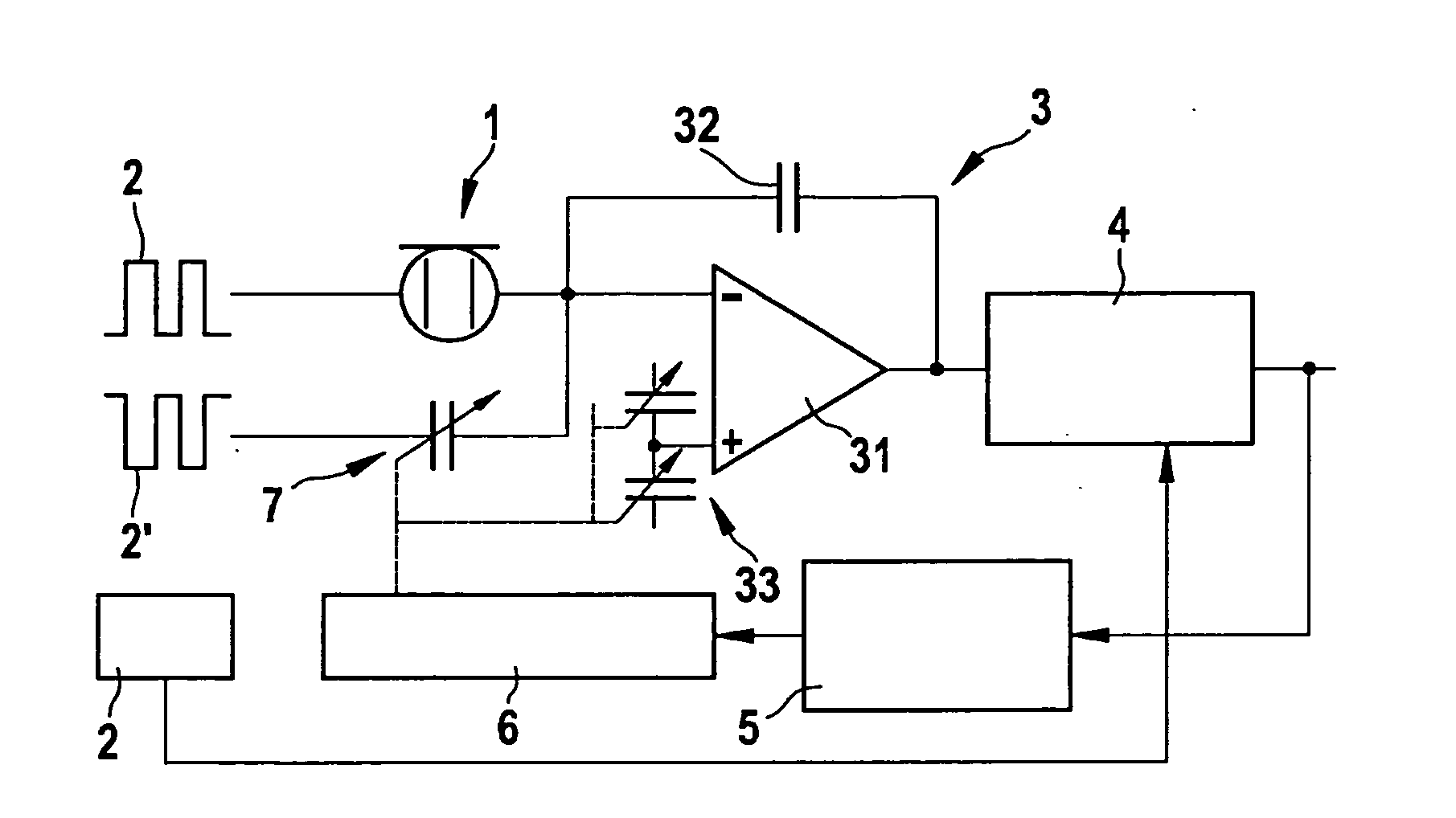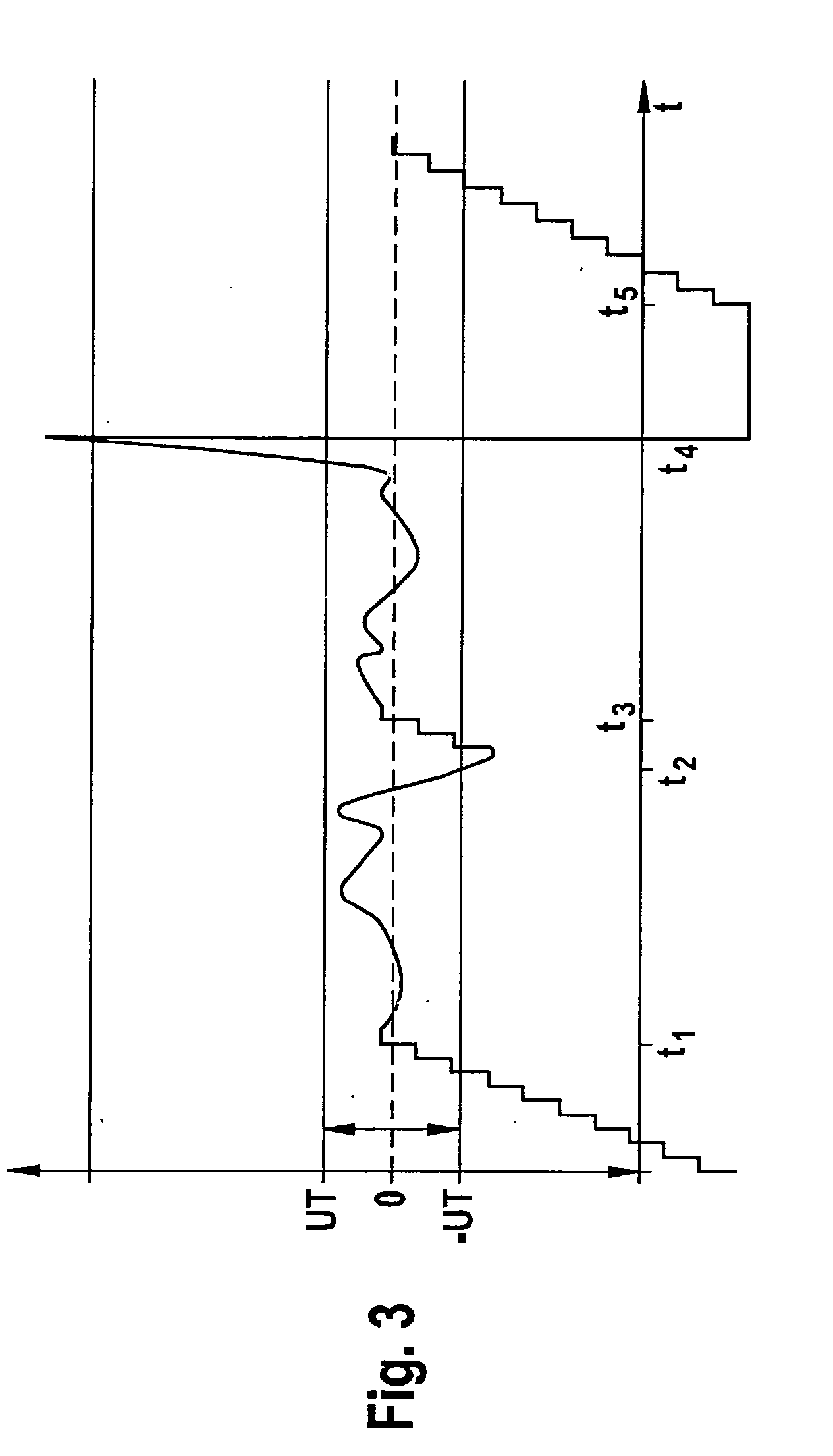[0012]The present invention proposes a concept for a
MEMS microphone which may be operated at a relatively
low voltage level while still having comparatively high sensitivity. In addition, such a
MEMS microphone may be manufactured in a very cost-effective manner.
[0015]The adjustable compensation capacitor is used for compensating for the
direct current component which flows through the microphone capacitor and which is due not to acoustic effects, but rather is manufacturing-related or, for example, occurs due to drift behavior of the microphone capacitor. Ideally, the compensation capacitor is adjusted corresponding to the quiescent capacitance of the microphone capacitor. Since the inverted
clock signal is present at the compensation capacitor while the microphone capacitor is supplied with the
clock signal, the
operational amplifier integrates only the component of the current flow through the microphone capacitor which is due to the acoustically related changes in capacitance of the microphone capacitor. Based on the output signal of the integrating operational
amplifier, a
microphone signal which reflects these changes in capacitance may then be obtained relatively easily, namely by synchronized
demodulation and low-pass filtering.
[0016]At a
voltage level of the high-frequency
clock signal of less than 2 volts, the type of signal detection according to the present invention provides acceptable sensitivity, i.e., a sufficiently high SNR. This is also advantageous in particular in overload situations. Namely, for voltages in this range, contact between the diaphragm and the counter electrode does not result in melting of the contact surfaces, and therefore also does not result in destruction of the microphone structure. For this reason, within the scope of the concept according to the present invention,
mechanical overload protection in the form of electrically insulating stops may be dispensed with.
[0018]In one particularly advantageous specific embodiment of the present invention, the compensation capacitor is automatically adapted to the quiescent capacitance of the microphone capacitor. This regulation is based on the direct-
current voltage component of the demodulator output signal, since this direct-
current voltage component corresponds to the
asymmetry between the microphone capacitor and the compensation capacitor. The direct-
current voltage component may be ascertained very easily with the aid of an offset filter provided downstream from the demodulator. To ensure that only the direct-current
voltage component is actually filtered out, the upper limiting frequency of this offset filter should be considerably less than the lower limiting frequency of the microphone. The compensation capacitor is then easily adjusted in such a way that the direct-current
voltage component of the demodulator output signal is minimized.
[0023]If physical contact occurs between the movable diaphragm and the stationary counter electrode in an overload situation, the microphone capacitor is
electrically short-circuited. At this moment the direct-current voltage component increases very rapidly and very intensely before the microphone function completely breaks down, since the diaphragm generally remains adhered to the counter electrode due to the electrostatic conditions. In one advantageous specific embodiment of the present invention, such an overload situation is detected based on the peak-like curve of the direct-current voltage offset signal. For this purpose, the direct-current voltage component is periodically compared to a predefined maximum limiting value. If the direct-current voltage component exceeds this maximum limiting value, an electrical reset is automatically carried out in which the microphone capacitor is discharged in order to detach the diaphragm from the counter electrode and restore the microphone function. Thus, in this variant of the present invention a type of overload protection for the microphone component is achieved solely by circuitry. In this case corresponding mechanical measures may be dispensed with, which overall greatly simplifies the manufacturing process for the component according to the present invention.
[0025]In one particularly advantageous refinement of the present invention, the direct-current voltage component of the demodulated signal is used not only for adapting the compensation capacitor and / or for monitoring the microphone function, but also for detecting accelerations which act on the microphone component. Use is made of the fact that basically any
capacitive microphone structure is also sensitive to accelerations such as the acceleration due to gravity, for example. If an acceleration acts perpendicularly to the microphone diaphragm, the microphone diaphragm is deflected due to its
mass and flexible suspension, resulting in a corresponding change in capacitance. These are generally static, or at least very low-frequency, changes in capacitance which are reflected in the signal curve of the direct-current voltage component. Thus, when the signal curve of the direct-current voltage component is appropriately evaluated, the concept according to the present invention allows the detection of accelerations acting perpendicularly to the microphone diaphragm without the need for an additional sensor element. Thus, using this concept, it is possible not only to implement a very inexpensive microphone having comparatively high sensitivity and robustness, but also to detect motions or merely only changes in position of the built-in device, without additional sensor elements. The component according to the present invention could be used, for example, within the scope of a telephone or PDA in order to recognize whether the device is moved or is resting on a table, and then to automatically switch between a vibrating alarm and a ring. For a telephone application, individual control actions such as, for example, switching a keylock on or off or accepting or refusing an incoming call, could be initiated via simple gestures, for example by rotating the device about a certain axis.
 Login to View More
Login to View More  Login to View More
Login to View More 


